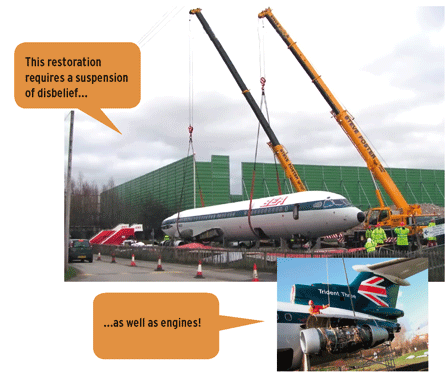Trident rebirthThe Hawker Siddeley Trident 3B preserved at Manchester airport's aviation viewing park has been returned to its former glory following a three-week rebuild. The 36-year-old ex-BEA/British Airways Trident (G-AWZK) spent many years with the UK airline's ground operations training division at Heathrow before being dismantled to be taken by road to Manchester in 2005. The Rolls-Royce Spey powered "quadjet" - uniquely the Trident 3B was equipped with a small boost engine in the tail to provide supplementary thrust in "hot and high" conditions - has spent the last 18 months awaiting the rebuild to begin, during which time it has undergone a major restoration effort by a dedicated team of volunteers. The rebuild was carried out by Simulation TERS and the aircraft will be ready for its official opening by Easter. Resplendent in BEA's turquoise livery from the late 1960s, the Trident is on display alongside various other UK airliners, including a British Airways Concorde. Manchester's aviation park is open daily. A visit on board the Trident costs £3 ($6) and includes an audio-visual and guided tour. For more information on Zulu Kilo, go to www.classicbritishaviation.org
|
Divine intervention?Luck, divine intervention or a robust, well-designed aircraft? Probably all of the above helped the crew of a Beech King Air B200 that made a successful emergency landing recently at Cape Giardeau, Missouri, with a cracked windshield, buckled skins and much of its horizontal stabiliser gone. According to The Southeast Missourian, the incident began with a windshield failure at 27,000ft (8,230m). Sheldon Stone and co-pilot Adam Moore donned their oxygen masks and depressurised the aircraft to prevent the windshield from blowing out. Stone twisted the valve to begin the flow of oxygen, but felt it was not coming. "We were both getting drunk really fast. I remember thinking, really slowly, 'Hey, I'm not getting any oxygen, what's wrong here?' The pilots passed out and came to with their aircraft nose down at 7,000ft at a high rate of speed. They recovered with difficulty and declared an emergency, diverting to Cape Girardeau airport. Somewhere in the descent or recovery, the airframe had suffered structural damage and pitched up when accelerated and down when slowed. Stone felt there was a window of control and picked a speed of 160kt (295km/h) for approach. The aircraft landed at about 145kt without further incident. Stone attributes his good fortune in part to the aircraft's heritage. The King Air was formerly owned by a Christian Assembly of God association combining that name with a holy number for its former registration, N777AG. The registration change to the current N777AJ now acknowledges "Assembly of Jesus". |
|
Source: Flight International

























